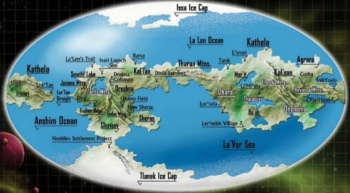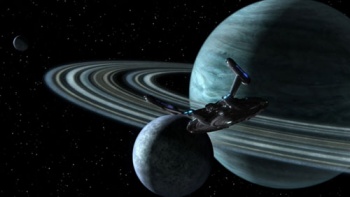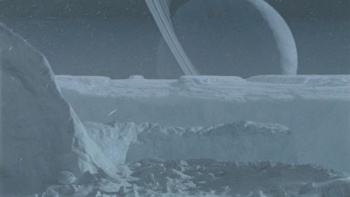Andoria
| Official Name: | Andorian Empire[1] |
| Affiliation: | United Federation of Planets[2] |
| Orbital Period: | 300 days[3] |
| Rotational Period: | 30 hours[3] |
| Class: | M[3][4] |
| Gravity: | 1.0g[3] |
| Points of Interest: | Andorian Military Academy,[3] Lor'Tan,[4] Lor'Tan Great Hall,[3][4] Andoria VII Observatory,[3] Atlin Zoological Park[4] |
| Notable Species: | Andorians,[2] Aenar[5] |
| Notable Individuals: | Krotus,[4] Lor'Vela,[3][4] Shran,[1] Kor, Igrilan,[4] Kor, Trallex,[3] P'Trell, Ghee[6] |
| Notable Events: | Age of Lament,[3][4] |
A cold world with relatively few natural resources, Andoria nevertheless gave rise to an advanced civilization that played a key role in galactic events. Not a planet, Andoria is actually a moon[5][Notes 1] of the eighth planet in the Procyon system in the Andorian Sector (aka Sector 006) of the Beta Quadrant,[7] a ringed Class J gas giant[5] named Olith.[4][Notes 2]
Environment
Unquestionably, Andoria is cold. Orbiting a Class J gas giant[5] at the outermost edges of the Procyon system, it is an extreme example of a Class M world.[7] Without the heat generated by Andoria's core, which manifests itself on the surface in the form of volcanoes and volcanic rifts, the world might not have developed life at all. An estimated 85 percent of all the animal life on Andoria lives within 15 degrees latitude of the equator.[4]
These relatively temperate zones have a climate similar to the taiga zones on Earth. Long, cold seasons are interrupted by brief but warm summers.[3][5] The warmer conditions, coupled with the heavy summer tourist season, make summers the least favorite time of year for many Andorians.[3]
Dense forests cover much of the Andorian landscape. Trees similar to the redwoods and sequoias of Earth—their blue color notwithstanding—number among Andoria's most prominent species of trees. The coloration of the trees, like that of most of the moon's lifeforms, has a blue tint that ranges from the deep blue-green leaves of the deciduous trees along the equator to the vibrant blue of the mountaintop conifers more common near the arctic regions. The Andorian Blue Taiga, known for its brilliant azure hues, makes for a popular tourist destination that rivals the national parks of Earth in beauty and majesty.[3]
Andoria's water has relatively high concentrations of cobalt, which accounts for the high levels of the heavy metal in Andorian blood. The presence of cobalt also makes Andorian water mildly toxic to Humans unless it is first purified. While Humans can comfortably breathe the Andorian atmosphere for short periods of time,[5] prolonged exposure to the moon's thin atmosphere leaves many fatigued. As a result, Andorian architects typically outfit Federation and Starfleet buildings with atmospheric conditioners that can create an earthlike atmosphere.[3]
Geography

Andoria's landmass is divided into four continents: Issa, Ka'thela, Tlanek, and Voral. Issa and Tlanek are both frozen solid and inhospitable, covered at virtually all times by glacial ice sheets that can be hundreds of meters thick. Nearly all of Andorian civilization resides on the continents Ka'thela and Voral, which are joined by a thin strip of land that contains the Tharan Mountains. Historically, this serves as Andoria's most important overland trade route.[4]
Government
Clans, or kethni, form the basic structure of Andorian society.[3][4] A strong chieftain rules each keth, typically having gained the position through ritual combat, although in some cases the position is passed by heredity.[3] Originally, kethni were huge, extended families and confederations of family units related to one another by blood. As Andoria entered its Industrial Age and families were less likely to stay tied to the same location long enough for traditional clan ties to solidify, the definition of kethni changed to include clans based on economic, professional, or ideological grounds. Kethni also came to represent groups based on the common interests of their members. Even so, these newer kethni command the same loyalty from their members as that shown to the old family-based clans.[4] Together, the leaders of the three hundred largest clans form the Kethni Council, the unified world government which came into being following the reforms instituted by Lor'Vela in the wake of the Age of Lament.[3][4] Officially, each of the clan leaders was equal to every other leader, but in practice, several clan leaders wield more power due to the strength and influence of their clans, the alliances they share with other clans, and also due to their own personal age and experience.[3] In the 2360s and 2370s, the most powerful member of the council was Trallex Kor, the eldest clan leader in the council and the leader of Clan Kor, the strongest and most powerful clan on Andoria.[3]
Although Andoria never wavered in its commitment to the Federation, the Kethni Council maintained Andoria's autonomous military force—the Andorian Imperial Guard (renamed the Andorian Defense Forces following the formation of the Federation)—as well as its own intelligence service, the Am Tal, or "Seeker of Secrets." The Am Tal is so secretive, the Federation knows of it only through rumor, and its mandate is to ferret out information—be it political, military, or economic—that would help the Andorian government and track the activities of kethni that had been censured by the Kethni Council. Am Tal operatives work under deep cover, and are recruited from all walks of life. They continue to lead their daily life while secretly helping the organization gather information. The existence of the Am Tal is controversial, but also represents a romanticized ideal of modern-day Andorian warriors, fighting the good fight against Andoria's enemies.[4]
Notes
- ↑ The Star Fleet Technical Manual listed the Andoria system as being the Epsilon Indii system. "Planets of the UFP: A Guide to Federation Worlds" and "Worlds" both listed Andoria as being the fifth planet of an otherwise-unspecified Andoria system, with a single G2III primary, also named Andoria. "Star Trek: Star Charts," however, established that Andoria was the eighth planet in the Procyon system, in keeping with the Star Trek: Enterprise episode, "The Andorian Incident," which established that Vulcan and Andoria were "neighboring systems." The episode "The Aenar" further established that Andoria was a moon in orbit of a ringed gas giant. To reconcile these conflicts, Andoria is listed here as Procyon A VIIIa, or the moon of the eighth planet orbiting Procyon A, in keeping with facts established in "Star Trek: Star Charts," which is most closely in line with those facts established on screen.
- ↑ "Worlds" gave the name of Andoria's moon as Olith. "The Aenar," however, established that Andoria itself was the moon of an otherwise-unnamed gas giant. Rather than discard the name entirely, the conflict has been resolved by transferring that name to the gas giant.
References
- ↑ 1.0 1.1 "The Andorian Incident". Enterprise, episode 7. Television. Paramount Pictures Corporation, 31 October 2001.
- ↑ 2.0 2.1 "Journey to Babel". Star Trek, Episode 44. Television. Desilu Studios, 17 November 1967.
- ↑ 3.00 3.01 3.02 3.03 3.04 3.05 3.06 3.07 3.08 3.09 3.10 3.11 3.12 3.13 3.14 3.15 3.16 3.17 3.18 "Planets of the UFP: A Guide to Federation Worlds". Star Trek: The Next Generation Roleplaying Game, supplement 25102. Game. Last Unicorn Games, 1999.
- ↑ 4.00 4.01 4.02 4.03 4.04 4.05 4.06 4.07 4.08 4.09 4.10 4.11 4.12 4.13 4.14 "Worlds". Star Trek Role Playing Game, book 7. Game. Decipher, Inc., 2005.
- ↑ 5.0 5.1 5.2 5.3 5.4 5.5 "The Aenar". Star Trek: Enterprise, episode 90. Television. Paramount Pictures Corporation, 11 February 2005.
- ↑ "Prophet Motive". Star Trek: Deep Space Nine, episode 462. Television. Paramount Pictures Corporation, 20 February 1995.
- ↑ 7.0 7.1 "Star Trek: Star Charts". Star Trek (Miscellaneous). Book. Simon & Schuster/Pocket Books, October 2002.

